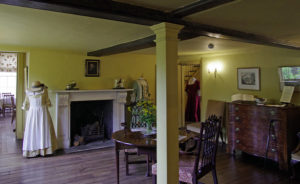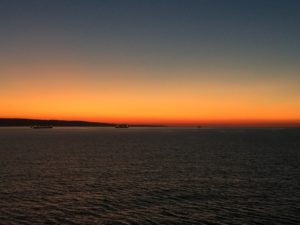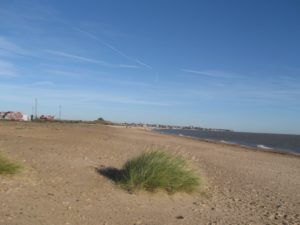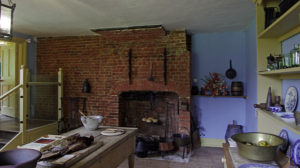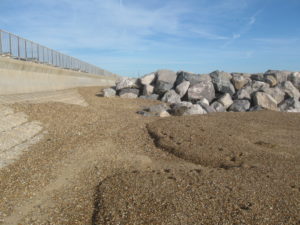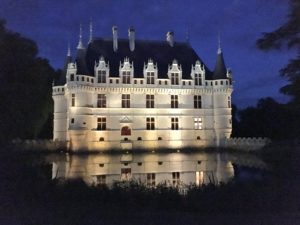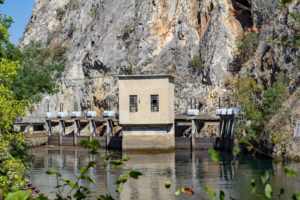The east coast of England is always windy, whether the fashionable Heritage Coast or more down-to-earth Felixstowe further south. It was no exception this November.
There is a good car park outside Landguard Fort but for walking into town from there the hourly bus (number 77) is more convenient than driving yourself. For those in need of sustenance the Lookout Point cafe seems always open. The view is inland, towards the recently enlarged container port on land owned by Trinity College, Cambridge, or towards the North Sea.
Chilly weather means a mid-morning drink may be ill-advised, so I stayed just a moment outside the cafe and looked towards the Essex side of the estuary, where the small ferry will take passengers several times a day. A ship was just heading in towards the port and the cranes looked like carnivorous dinosaurs ready to devour its cargo.
There are the remains of what may have been a curtain wall around the fort, built to resist Napoleon, and nowadays useful as a footpath. The shingle foreshore seems to be good for anglers, as the first of half a dozen was casting into the waves.
Shingle in winter is not as lifeless as may appear from a distance. A close look showed a tiny pimpernel-like flower. Further on there were bugloss, A pair of pied wagtails was performng short flights followed by the characteristic see-saw of the tail.
This area is in fact a protected nature reserve, and on a previous visit I preferred it to the fort. This time there was no choice, as the fort was closed and looked it, very low behind its embankment. The nearby dock area seems to dwarf it.
Felixstowe is distantly visible after rounding the fort. As the tide was at the mid-point I walked along the beach. Some grasses were standing tall and seemed unsure if the prevailing wind was from from the sea or the shore.
Surge tides have often threatened the land hereabouts so there is a sturdy wall that will be needed, unlike the fortifications. It was essential only a couple of years ago, when parts of the coast were overwhelmed. Further north some areas will be given up as the sea encroaches. Here the land is too valuable, as the nearby presence of Trinity College interest confirms.
Seaside towns always offer curious architecture. A small house built to resemble an overgrown child’s fort is nowadays required only to defend a static caravan park. The sea almost seems to need defence from the park, as the shingle has been pushed up into the form of sculptured breakers. The mobile versions were making a double sound as they hit the shore, reminding me of the gasp-and-grunt of our Anglo-Saxon ancestors rowing home. The town is of course named after the earliest missionary to those people.
Felixstowe was once a fashionable holiday resort, with German and Russian royalty among its visitors. Beach huts are a reminder – no doubt more affordable than those of Southwold. One appeared to be in use, with a windbreak outside. It was in fact a pop-up charitable coffee shop. Another was too, with its people outside and their kayaks inside: an interesting scale of values.
Further along is a martello tower, now also operating as a refreshment room, behind a fenced section of nature reserve. The signboard showed it was a haven of food plants for butterflies. Houses behind would be worth half-a-million or more in trendy Aldeburgh but are probably less than half that price. Good value if you want to live by the sea.
Day-trippers seem more the clientele for Felixstowe these days. At the southern end they have amusement arcades and fish and chip bars. Walk into town though and the recently restored seafront gardens are a delight, with rockeries and imaginative planting. A friend met two days later said he’d been to the cinema for a pre-release showing of “I, Daniel Blake.” It must be an imaginatively programmed cinema.
Time was passing so the gardens and other parts of the town had to be given a miss. The swimming pool – not in any case my destination – stands just back from the pier. Work was going on, but whether to reinforce the sea defence or demolish the pier wasn’t clear. Certainly Felixstowe pier is a very poor relation of Southwold.
Convalescence Hill would be hard work for anyone actually recovering from illness or treatment but it gives a good view back along the shore to Landguard. A couple of minutes’ walk beyond is a bus stop. My watch told me the bus should be leaving Landguard at that moment, and in a few minutes it arrived.
The walk had taken about an hour. It was only about a mile but plenty on a windy day with time taken out for photographs and exploring what there was to see. Oh, and I could have stopped for a drink. There is a strategically sited public lavatory in good order. Felixstowe has a very thoughtful local council.
